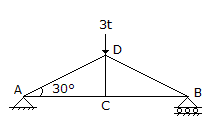Civil Engineering - Theory of Structures - Discussion
Discussion Forum : Theory of Structures - Section 4 (Q.No. 6)
6.
The force in BC of the truss shown in the given figure, is


Discussion:
6 comments Page 1 of 1.
Hasan said:
8 years ago
How itis calculated? Please explain.
Sheela said:
8 years ago
Give a clear explanation of the answer.
Anbu said:
8 years ago
Take moment about B.
Va * l - 3t*l/2 =0.
Va= 3t/2 then Vb=3t/2.
consider joint B.
Fbdcos30 + Vb=0.
Fbd= - 3t/ ( 2sin30).
SUM H= 0.
-Fbc-fbdcos30=0
THEN Fbc= 3t (3)^(1/3) /2.
Va * l - 3t*l/2 =0.
Va= 3t/2 then Vb=3t/2.
consider joint B.
Fbdcos30 + Vb=0.
Fbd= - 3t/ ( 2sin30).
SUM H= 0.
-Fbc-fbdcos30=0
THEN Fbc= 3t (3)^(1/3) /2.
(1)
Prayag said:
6 years ago
We can also solve by the truss method.
i.e., the bc member is pcotθ where θ is 30°.
And more ever CD is a zero-member hence we get a symmetrical structure so the reaction is equal.
Now the value of p we get is 1.5 and cotθ= √(3). So answer we get is (3/2)*√(3)
i.e., the bc member is pcotθ where θ is 30°.
And more ever CD is a zero-member hence we get a symmetrical structure so the reaction is equal.
Now the value of p we get is 1.5 and cotθ= √(3). So answer we get is (3/2)*√(3)
Karn chaurasiya said:
6 years ago
Here,3 cot 30= 3√3/2tension.
Ahmed said:
5 years ago
The correct answer is A.
Post your comments here:
Quick links
Quantitative Aptitude
Verbal (English)
Reasoning
Programming
Interview
Placement Papers
 t tension
t tension